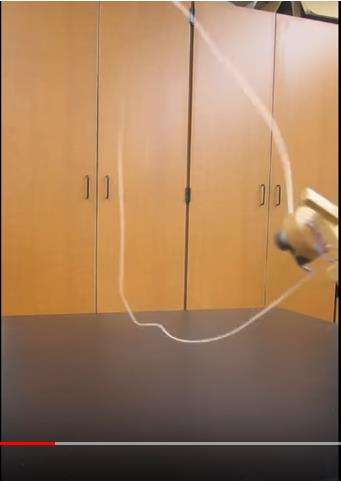Vince,Gordy, did you watch it with the sound off, he explains the mechanics. It no more generates lift than a lasso does and would work perfectly well in a vacuum
I assume this is the explanation he gave that you thought was a complete explanation of the mechanics of the levitating loop in the string shooter:
As stated in Wikipedia in today's thinking inertia is referring to an objects to mass.There is an old saying that you can’t push string, but in this case that is exactly what we are doing. The wheels push it forward. It has inertia that keeps it pushing forward until the loop is pulled back towards the machine and then it gets pushed again.
However Wikipedia also notes that:Inertia comes from the Latin word, iners, meaning idle, sluggish. Inertia is one of the primary manifestations of mass, which is a quantitative property of physical systems.
So let us assume he meant "The line has "momentum" that keeps it pushing forward". If we assume that "pushing" is referring to a force then he is making the common mistake of equating momentum with a force.In common usage, the term "inertia" may refer to an object's "amount of resistance to change in velocity" (which is quantified by its mass), or sometimes to its momentum, depending on the context. .
Thus if Newton was correct and it takes change in momentum to produce a force his explanation of the mechanics of the string shooter does not wash.
It might work in a vacuum, but that does not explain the difference in the width of the legs and the shape of the loop when he changes the launch angle of the shooter. I would think those changes are only effected by the angle of the forces produced by the skin drag on the line.
If it was just the momentum change at the loop that was producing the tension in the string, then I would think the axis of loop would rotate in the plane that was created at the source of the shooter. It doesn't do that as you can see the loop remains aligned in a vertical plane even though the angle of the shooter was changed as shown here:

Maybe this is another interesting experiment for Dr. John Biggins to explain based on some real physics as he did with the chain fountain.
So what force (or forces) do you think is offsetting the force of gravity on the mass of the spinning loop? It can't be momentum.
Gordy
